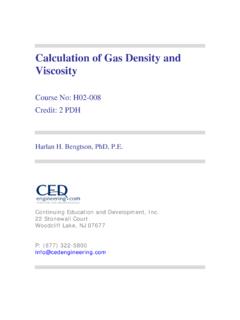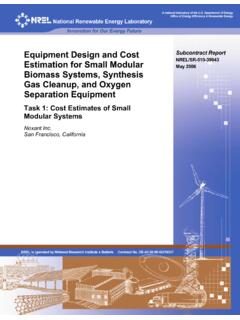Transcription of Gas-Liquid Separators Sizing Parameter
1 SEPTEMBER 2015 PRODUCTION & PROCESSING FACILITIES TIP OF THE MONTH 1 2015 PetroSkills, LLC. All rights reserved. Gas-Liquid Separators Sizing Parameter In the December 2014 tip of the month (TOTM) [1], we discussed troubleshooting of Gas-Liquid Separators for removal of liquids from the gas stream leaving the separator . There are two methods for Sizing Gas-Liquid Separators : 1. Droplet settling theory method, 2. Souders-Brown approach. Historically the Souders-Brown equation has been employed as it can provide reasonable results and is easy to use, but has shortcomings in terms of quantifying separator performance. References [2-4] provide the details on the droplet settling theory methods which can be used to more accurately quantify separator performance. The Souders-Brown method is limited in that it is based on the average droplet size, but cannot quantify the amount of liquid droplets exiting the gas gravity section.
2 In this TOTM, we will focus on the application of Souders-Brown approach in Gas-Liquid Separators and present diagram, simple correlations and tables to estimate the Souders-Brown equation constant, KS (the so called Sizing Parameter ). We will consider both vertical and horizontal Gas-Liquid Separators . Knowing the actual gas flow rate through the vessel, one can use KS Parameter to determine the maximum allowable gas velocity through the vessel and determine the required separator diameter. One can also use the appropriate value of KS to size the mist extractor in the vessel. The performance of a Gas-Liquid separator is highly dependent on the value of KS; therefore, the choice of appropriate KS values is important. Gas Gravity Separation Section The gas gravity separation section of a separator has two main functions: 1. Reduction of entrained liquid load not removed by the inlet device 2.
3 Improvement / straightening of the gas velocity profile. Most mist extractors have limitations on the amount of entrained liquid droplets that can be efficiently removed from the gas, thus the importance of the gas gravity section to remove the liquids to an acceptable level upstream of the mist extractor. This is particularly important for Separators handling higher liquid loads. For scrubber applications with low liquid loadings, the KS values will be primarily dependent on the mist extractor type, and the gas gravity separation SEPTEMBER 2015 PRODUCTION & PROCESSING FACILITIES TIP OF THE MONTH 2 2015 PetroSkills, LLC. All rights becomes less important. For the higher liquid load applications, conventional Separators , there are two approaches for Sizing the gravity separation section to remove liquid droplets from the gas: 1. The Souders-Brown approach (Ks Method) 2.
4 Droplet settling theory The Souders-Brown Approach If we consider a spherical liquid droplet with a diameter of DP in the gas phase two forces as shown in Figure 1 act on it. The drag force, FD, is exerted by flow of gas and gravity force, FG, is exerted by the weight of droplet. The drag force acts to entrain the liquid droplet while the gravity force acts to pull it down and separating it from the gas phase. Figure 1. Schematic of the forces acting on a liquid droplet in the gas phase [5] Assuming plug flow with no eddies or disturbances, a single droplet and ignoring the end effect, at equilibrium (free fall or terminal velocity), these two forces are equal. DGFF (1) As presented in the Appendix, substitution of expressions for the drag and gravity forces in Equation 1, the maximum allowable gas velocity, VGmax, which prevents entrainment of liquid is obtained.
5 SEPTEMBER 2015 PRODUCTION & PROCESSING FACILITIES TIP OF THE MONTH 3 2015 PetroSkills, LLC. All rights reserved. GmaxLGSGVK (2) Equation 2 is called Souders-Brown [6] equation and KS is referred to as the design or Sizing Parameter . The terms G and L are the gas phase and liquid phase densities, respectively. Once the maximum gas velocity, VGmax, through the vessel is determined by Equation 2, one can calculate the minimum vessel diameter, Dmin by Equation 3. minmax(4/ ) /()aGGDqFV (3) Where: FG = Fraction of cross section area available for gas flow (FG = 1 for vertical Separators and is a function of liquid height for horizontal Separators ) qa = Gas flow rate at the actual flowing condition The Design Parameter , KS The design Parameter , KS, in the Souders-Brown equation is an empirical Parameter and is a key factor for the Sizing the Gas-Liquid Separators vessel diameter as well as for determination of the mist extractor diameter.
6 Its value depends on several factors including: Pressure Fluid properties (note temperature has a large impact on fluid properties) separator geometry o Vessel length and the liquid level (for horizontal Separators ) Steadiness of flow Inlet device design and performance relative amounts of gas and liquid Most importantly mist extractor type and design ( mesh pad, vane pack, multi cyclone) There are several sources that one can look up the KS values for different applications. In the following sections, we will discuss three sources. SEPTEMBER 2015 PRODUCTION & PROCESSING FACILITIES TIP OF THE MONTH 4 2015 PetroSkills, LLC. All rights API 12 J The API 12J [7] recommends ranges of KS values for vertical and horizontal Gas-Liquid Separators . These values are presented in Table 1. The equivalent of API 12J for the North Sea region is NORSOK P-100.
7 Table 1. API 12 J recommended range of KS values for vertical and horizontal Separators [7] Type Height or Length, ft (m) Typical KS range, ft/sec Typical KS range, m/s Vertical 5 ( ) to 10 ( ) to Horizontal 10 ( ) to to Other Lengths to (L/10) to ( ) Per API 12J, the maximum allowable superficial velocity, calculated form the above factors, is for Separators normally having a wire mesh mist extractor. This rate should allow all liquid droplets larger than 10 microns to settle out of the gas. The maximum allowable superficial velocity or other design criteria should be considered for other type mist extractor. Mist extractor manufacturer's recommended minimum distances upstream and downstream of the wire mesh between gas inlet and outlet nozzles should be provided for full utilization of the mist extractor. These values assume Separators are equipped with standard mesh pad mist extractors [7].
8 B. Campbell Book The Ks method, Equation 2, is an empirical approach to estimate the maximum allowable gas velocity to achieve a desired droplet separation. For vertical Separators with no mist extractor devices, Chap 11, Vol 2 of the Gas Conditioning and Processing book presents KS as a function of pressure and liquid droplet size [5]. This dependency of KS on pressure and droplet size is presented in Figure 2 [5]. Note for each droplet size a range of KS values are given for a specified pressure. For horizontal Separators , the Sizing depends on (in addition to the droplet size, density of gas and liquid phases, and gas velocity) separator effective length, Le, and the depth available for gas flow, hG, ( liquid level) in the Separators . SEPTEMBER 2015 PRODUCTION & PROCESSING FACILITIES TIP OF THE MONTH 5 2015 PetroSkills, LLC. All rights reserved. Figure 2.
9 KS as a function of pressure and liquid droplet size for vertical Separators with no mist extractor devices [5] Sizing of the horizontal Separators are more complicated. Referring to Figure 3, the effective Le may be defined in terms of separator actual length and diameter like Le=L-D. Therefore, the Souders-Brown Parameter for horizontal Separators , KSH, can be estimated in by Equation 4 in terms of KSV (read from Figure 2) for vertical separator [3]. /D(/)or/DeSHSVegSHSVgLKKLhKKh (4) If the calculated value of KSH by Equation 4 is greater than the maximum value of ft/sec ( m/s), it should be set equal to this maximum value. SEPTEMBER 2015 PRODUCTION & PROCESSING FACILITIES TIP OF THE MONTH 6 2015 PetroSkills, LLC. All rights reserved. Figure 3. Schematic of a horizontal Gas-Liquid separator [5] The horizontal separator Sizing is a trial-and-error procedure.
10 Normally, the Le/D and hg/D (or hL/D) are assumed and KSH, Vgmax, D are calculated by Equations 4, 2, and 3, respectively. The effective length and actual lengths are calculated by Equation 5. 24 LeeLtqLandLLDDF (5) Where: D = Diameter FL = Fraction of cross section area occupied by liquid (function of liquid height in horizontal separator ) qL = liquid actual volume flow rate t = Residence time per API 12J [7] If the calculated L/D is outside of its recommended range (normally 3 < L/D < 6), the liquid height in the vessel is changed and the calculations are repeated. For detail of calculations procedure refer to chapter 11 of reference [5]. SEPTEMBER 2015 PRODUCTION & PROCESSING FACILITIES TIP OF THE MONTH 7 2015 PetroSkills, LLC. All rights KS Correlations The curves for different droplet sizes shown in Figure 2 are fitted to a 3rd order polynomial (for droplet sizes of 100, 150, and 300 microns).







